Taxonomy
Descriptions
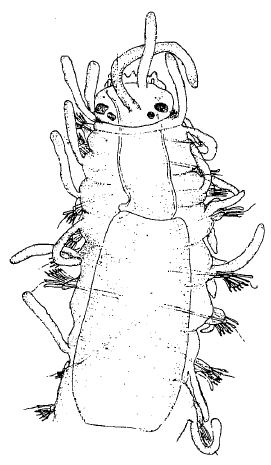 The longest specimen is 2.5mm, composed of 23 segments. it is complete posteriorly, except for the fat that the anal segment is damaged. This specimen is an immature female, with developing eggs in the body cavity. Another specimen, with the posterior part missing, had 31 setigerous segments. the body is widest in the region on the proventriculus, tapering very slightly towards the head, much more so towards the tail. Most of the appendages are missing, but those which remain are smooth and cylindrical, with no trace of moniliform articulations. The head is broad, and the width greatly exceeds the length. There are four large, reddish-brown eyes, with lenses. The appendages of the head are missing, but the base of the medium tentacle is seen between the anterior pair of eyes.
The longest specimen is 2.5mm, composed of 23 segments. it is complete posteriorly, except for the fat that the anal segment is damaged. This specimen is an immature female, with developing eggs in the body cavity. Another specimen, with the posterior part missing, had 31 setigerous segments. the body is widest in the region on the proventriculus, tapering very slightly towards the head, much more so towards the tail. Most of the appendages are missing, but those which remain are smooth and cylindrical, with no trace of moniliform articulations. The head is broad, and the width greatly exceeds the length. There are four large, reddish-brown eyes, with lenses. The appendages of the head are missing, but the base of the medium tentacle is seen between the anterior pair of eyes.
The palps lie on the ventral surface and are invisible from above. Their basal portions are closely fused with the ventral side of the head, and they terminate in slender papillae. Between the head and the buccal segment are the ciliated nuchal organs. The buccal segment is quite distinct from the head, and bears two pairs of smooth cirri. There is a patch of cilia on the dorsum above each foot.
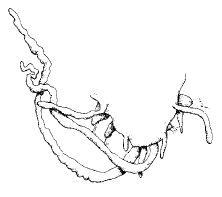
The anal region in all the specimens is more or less imperfect, but there seem to be a pair of short lateral cirri and a short slender median cirrus.
The feet are prominent, and the anterior six segments differ from those which succeed them. The first setigerous segment contains a simple dorsal seta, 8 compound setae, of which 7 have short tips and one a long tip, and a slender spine with a swollen tip. The 2nd to 6th feet have each a simple dorsal seta, 7-8 compound setae, of which 3-6 have short tips and 2 long tips, and one or two very thick spines with large swollen tips. Apart from these differences in detail, the setae of the 6 anterior segments are similar, and those of the third segment may be described as typical of the others.
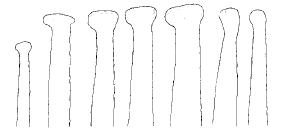
The setigerous lobe is blunt, and is supported by one or two very thick spines with swollen truncated tips.
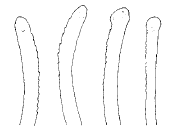
The dorsal simple seta is curved at the distal end, where it terminates in a point which is delicately winged, and serrated on the convex side.
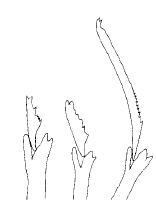
The compound setae are short and thick, the swollen tips of the shafts ending in 3 or 4 blunt teeth. The terminal pieces are distinctly bifid at the tip, 7 being short and 2 long. The edge of the long tips is coarsely serrated. In the succeeding segments the distinction between the setae with short and long terminal pieces disappears, and there is a gradual transition from the long dorsal to the short ventral tips.

Taking the 16th foot as typical of this region, it is seen that the setigerous lobe is more elongate, the spine is very slender, resembling that of the first segment and less than half a thick as the spines in segments 2-6. The dorsal simple seta is similar, except that the delicate wing at the tips is cup-shaped, but this may be due to abrasion.
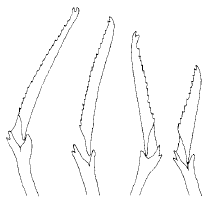
The compound setae are much longer and thinner, with distinctly bifid terminal pieces and serrated edges, the length of the terminal pieces decreasing from above downwards.
In the last 3 or 4 segments there is in addition a very slender simple seat in the ventral part of the foot. In the dorsal region of the middle and posterior feet there are two very slender spines. These may be the forerunners of the swimming setae which develop at maturity. The dorsal cirri of all the feet are long and cylindrical, with no indication of the moniliform condition. The ventral cirri are also very long, increasing in size from in front backwards. They are placed towards the extremity of the setigerous lobes and extend outwards beyond the setae. The great length of the ventral cirri seems to be a character of the genus Streptosyllis. The pharynx s short, straight and broad, without a tooth, extending through 3 segments. It has 8 papillae in front. The proventriculus is massive, extending through 6 segments, and has 48 rows of glands. None of the specimens are mature, but an immature female has eggs
beginning in the 12th segment.
Webster and Benedict do not state the number of segments in the anterior region of the body. The present species differs from S. arenae in many respects, especially in the shape of the setae, which have simple winged tips. S. varians differs from the present species in the length of the proboscis and proventriculus, in having some of the dorsal cirri moniliform, in the larger palps and the minute structure of the setae, and in the much greater number of anterior segments with thick spines. From S. websteri this species differs in having six segments in the anterior region, against five, and in the structure of the setae. [1]
Southern (1914) described S. websteri and S. bidentata, two close by related species which differ on the details of the setae an the number of segments provided with enlarged aciculae. The key proposed by Southern to separate both species is only based on the number of enlarged aciculae, a character considered as variable by several authors, and thus created some confusion. Hartmann-Schröder (1974) synonymized S. bidentata with S. websteri , but others such as Campoy (1982) and Parapar (1994) accept both as valid species. [2]

Add new comment